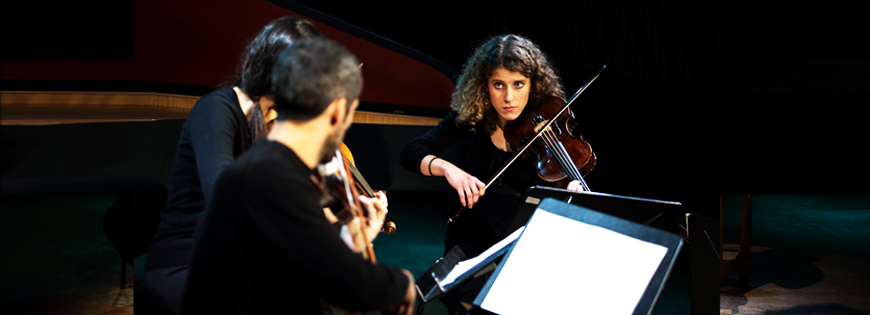Chamber music
The chamber music course at the Conservatoire royal de Bruxelles is graded by continuous assessment. This means that the teaching staff have great freedom and a good deal of flexibility in what they offer. The teaching team, consisting of the coordinator, three professors, and other teaching staff and assistants, have the task of supporting students in their personal learning trajectory which is evaluated throughout the course.
Vision
Repertoire : an authentic way of learning
Chamber music encompasses repertoire stretching from the baroque era to the 21st century, including key masterpieces which can be seen as essential parts of the historical legacy of humanity, alongside audacious works of music which pushed the language of music to evolve over the last three centuries. Each score presents artistic, stylistic, and technical difficulties which challenge a musician to ask questions and thereby continue to improve and develop their skills.
Preparing repertoire : learning to work together
Chamber music offers the chance for students to discover the pleasure of musical collaborations with other instrumentalists: each person's skills are used for the common purpose, requiring a certain humility in relation to the score in question. By combining the knowledge and performance skills of each student, while continuously striving to make the whole ensemble function at its best, students can learn to work in a group with a variety of personal convictions, differences of approach, methods of working, and even different personalities. This model of working and living together, is useful not just for music but is sometimes also referenced in management contexts in corporate settings.
Repertoire in concert : autonomous performers in connection with society
Chamber music can be performed in all sorts of settings within the city. Such concerts represent a kind of final moment during which the chamber music ensembles can draw on a range of various skills which will be necessary for their future profession. By acting as intermediaries between the composers and the public, an ensemble can provide high quality performance within the city, facilitating meetings between audience members, and expressing emotion: in a concert, there is no 'safety net', and this allows the musicians to test their skills, and check if their level of preparation is enough to fulfil their task as performers and transmitters of culture to the wider public. Participation in chamber music concerts is further facilitated by the fact that these important opportunities are relatively easy to organise in terms of logistics.

Our mission
At the Conservatoire royal de Bruxelles, the teaching team for chamber music coordinates the chamber music programme and supports students in their search for autonomy as they progress from "receiving" lessons, to being active cultural agents in society. In teaching the course, each teacher is able to draw on the training they themselves received, their own experience of previous artistic challenges and specific professional experience.
In terms of giving advice about what direction students might take, the teachers also draw on years of practical and teaching experience.This allows them to help students gain the greatest possible benefit from their skills and knowledge, with an emphasis on a reflective approach which allows the student to move on from the past and their first years of music practice.
An equally important objective is to support the chamber music ensembles as they organise performances or publicise their work.
Methods
In order to ensure a smooth transition to professional life after the end of their studies, the Conservatoire royal de Bruxelles encourages students to give public performances of prepared repertoire. The Conservatoire has a number things to facilitate this:
- the public season and concerts both within the Conservatoire and elsewhere. The concerts are planned together with the teachers and this allows ensembles - depending on how far they are in their preparation - either a movement, or an entire work, or even a full programme;
- the seies of Nocturnes where students can present freely-chosen repertoire;
- the "Courants d’airs" festival for which, each year, students can suggest an completely independent project;
- the Conservatoire's partnerships with a range of Brussels music institutions, such as Musiq’3, for which aronund fifteen ensembles are selected each year, and from which one will be programmed in Belgium for the following year.
The Conservatoire supports the desire of some ensembles to prepare a professionnal programme during their course. In recent years there have been numerous examples of groups which have taken this opportunity, to mention a few: Quatuor Akhtamar, Collectif Arsys, Ensemble Barroctout, Trio Erämaa, Quintette EtCaetera, Ensemble Fractales, Quatuor Kalištĕ, Collectif Mas Musici, Trio Oscillations, Trio Spilliaert…
These ensembles have also been able to take advantage of the courses in marketing and "Legal and Judicial Matters" to help promote their project. Most of these ensembles have collaborated with the composition classes, performing works written by teachers or by other students.
Implementation
Depending on the availability of the teachers, the chamber music classes are offered either every week, or with another schedule by arrangement with the teacher. The students can either sign up together with an ensemble and proposed repertoire, or they can register individually and the coordinator will suggest a group with other musicians which they can join.
The groups have evaluated performances twice a year which gives them a chance to perform the repertoire they have prepared.
The Conservatoire library is one of the best-resourced in Europe, allowing students to carry out research projects as well as borrowing music scores of repertoire. The chamber music class has also set up a "class library" which is expanded each year to include scores for ensembles formed of less common combinations of instruments.
The teaching team
The team responsible for chamber music boasts a wide range of experiences and specialities amongst its fifteen or so teachers. Strings, wind and piano players are all represented, including performers and specialists in various styles including baroque, classical, romantic, modern or contemporary, with ensembles ranging from trios to emembles with variable formations, alongside brass ensembles and string quartets.